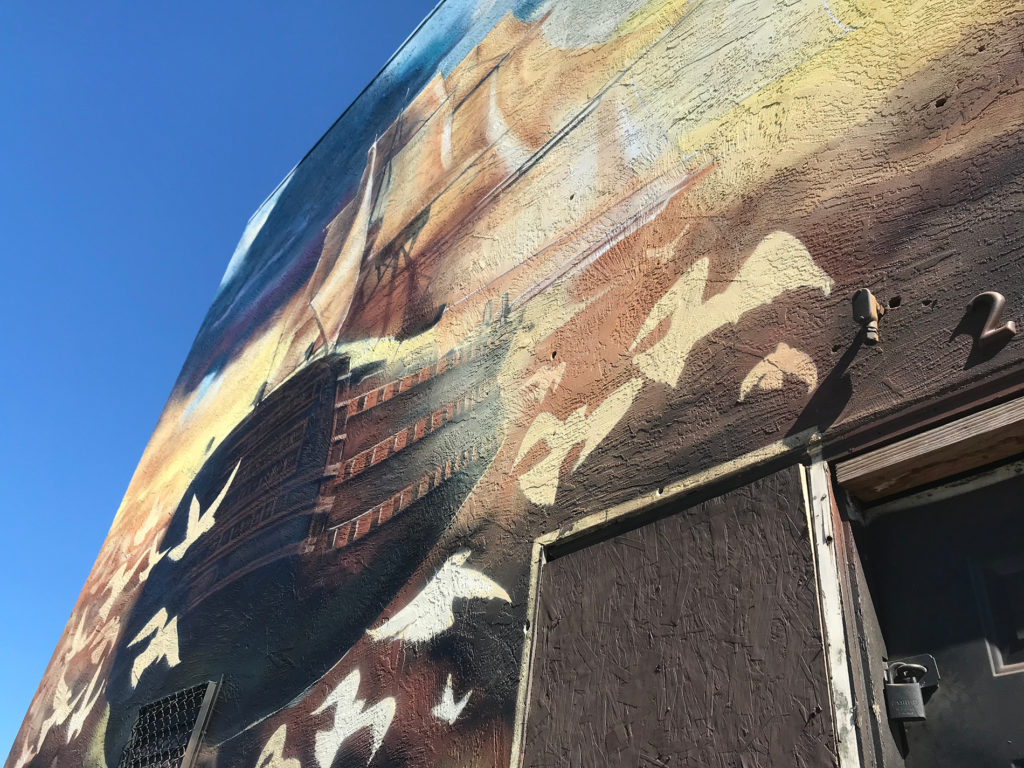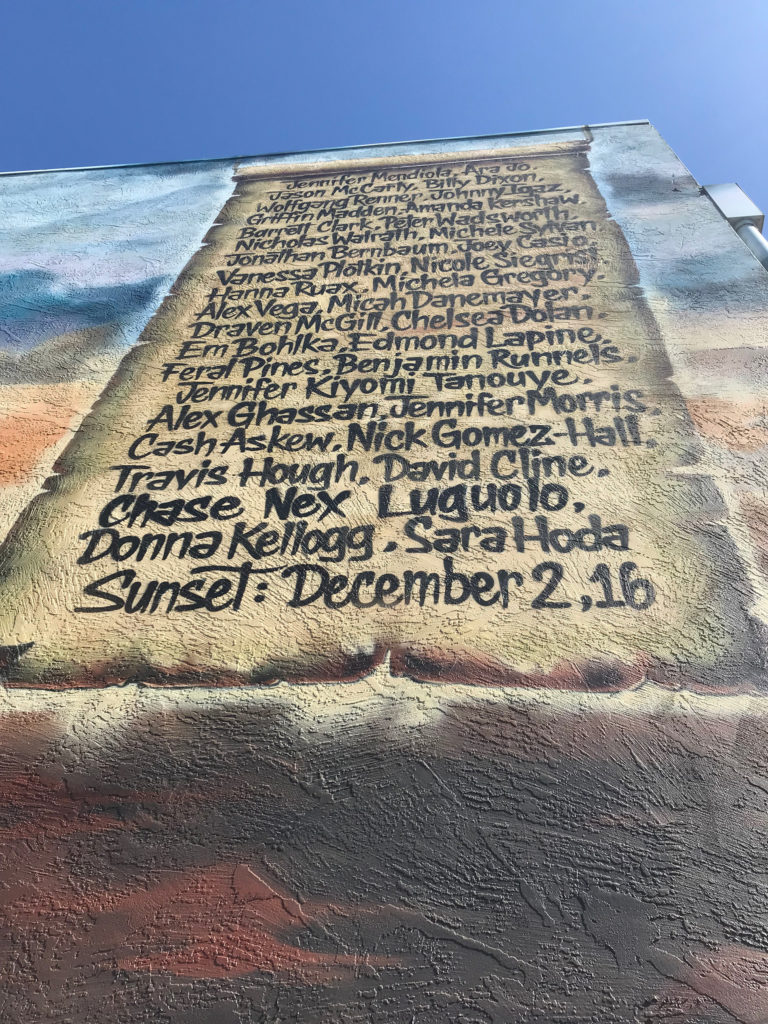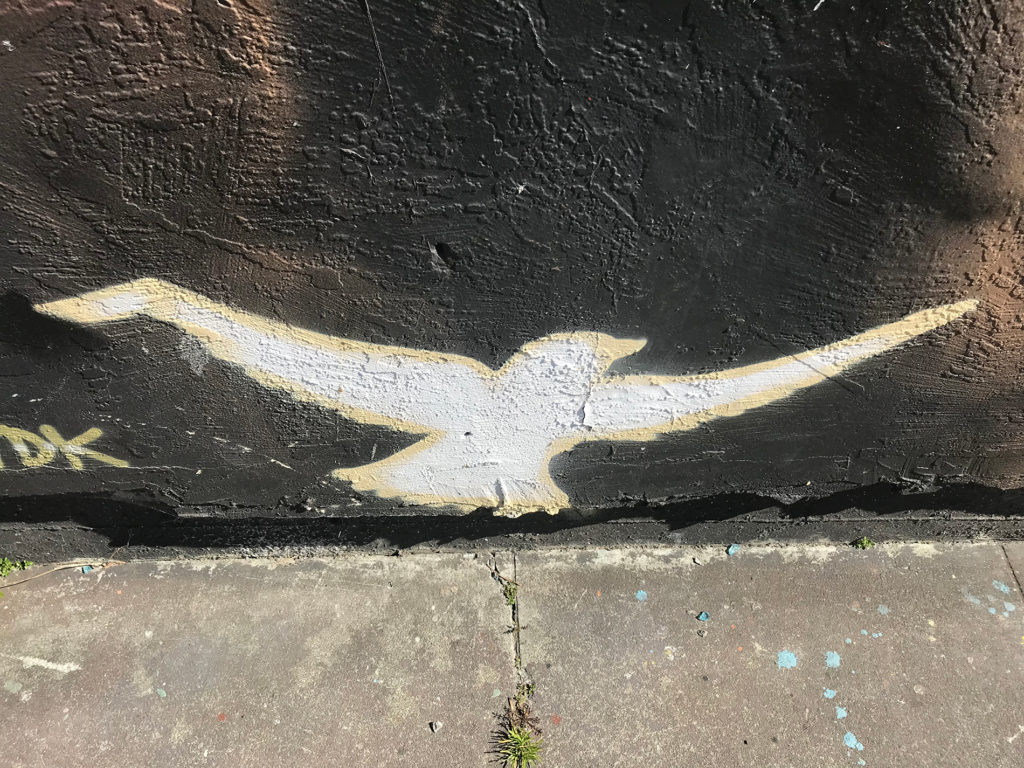Ghost Ship memorial mural
on January 1, 2019
Smashed between an auto body shop and a building supply warehouse is a mural. Blended in with the neutral tans and whites of its industrial surroundings, the brown and cream artwork sits hidden in plain view. No people stand to view it. No one in passing cars stops to stare. If they did, they would see 36 names listed on a painting of an old parchment scroll. Those are the names of the 36 people killed when a fire ravaged the “Ghost Ship” warehouse just a few blocks away. The December 2, 2016 fire at the warehouse was the deadliest in Oakland history.
Smashed between an auto body shop and a building supply warehouse is a mural. Blended in with the neutral tans and whites of its industrial surroundings, the brown and cream artwork sits hidden in plain view. No people stand to view it. No one in passing cars stops to stare. If they did, they would see 36 names listed on a painting of an old parchment scroll. Those are the names of the 36 people killed when a fire ravaged the “Ghost Ship” warehouse just a few blocks away. The December 2, 2016 fire at the warehouse was the deadliest in Oakland history.

A wall mural featuring ship and white doves glow in the late-morning sunlight as a memorial to the dozens who died in a 2016 warehouse fire. 
The names of all 36 who lost their lives in the Ghost Ship fire are listed a mural honoring their lives. 
Thirty-six white doves cover a Fruitvale mural each representing one of the people who died in the 2016 Ghost Ship fire.
The mural was spray-painted by the artist known as Vogue in 2017. It features a galleon sailing into the horizon with 36 white doves—representing the 36 people killed in the fire—flying up from beneath the hull and into the open air. A dark bluish-purple cloud looms overhead.
The image covers the entire front of a
square stucco building, every part of its dried Play-Doh textured surface. It
even covers the deadbolted door and two windows, but the outline of the windows
is still there. The windows are layers: chain link fence material covers metal
blinds that covers plywood.The framing for the door is rotting away. Chipped
indentations of varying depths are etched into the trim. Plywood covers one side
of the entry and above the door, the address is marked in three dimensional
characters that read “2234.” But the second 2 is missing, known only by the
outline of where it once hung.
Below the base of the mural are a few patches of weeds. Near one outer edge, a
tuft of green grass grows from beneath the building a few inches up the facade.
One the other side, a dandelion and its leaves jutt up from a crack in the
sidewalk. On the stoop below the door, splatters of yellow paint—not part of
the art—lay in the shape of an unintentional smiling face, plus a few random
splatters. Next to it and elsewhere on the sidewalk are shards of glass, clear
except one piece that shows the remains of a painted image.
The mural looks out across East 12th Street to a barren plot of land that once housed the community-run homeless encampment known as “The Village.” Now vacant, the site is just tilled dirt and trash. It’s surrounded by a chainlink fence with lines of barbed wire outlining the top. In a section next to the freeway exit grows a tangle of new green bushes.
At the mural, not one person passes by. Cars drive past: a pickup, an SUV, a Dunbar armored truck making its rounds. Overhead, a BART train screeches through. But no people.
The mural was spray-painted by the artist known as Vogue in 2017. It features a galleon sailing into the horizon with 36 white doves—representing the 36 people killed in the fire—flying up from beneath the hull and into the open air. A dark bluish-purple cloud looms overhead.
The image covers the entire front of a
square stucco building, every part of its dried Play-Doh textured surface. It
even covers the deadbolted door and two windows, but the outline of the windows
is still there. The windows are layers: chain link fence material covers metal
blinds that covers plywood.The framing for the door is rotting away. Chipped
indentations of varying depths are etched into the trim. Plywood covers one side
of the entry and above the door, the address is marked in three dimensional
characters that read “2234.” But the second 2 is missing, known only by the
outline of where it once hung.
Below the base of the mural are a few patches of weeds. Near one outer edge, a
tuft of green grass grows from beneath the building a few inches up the facade.
One the other side, a dandelion and its leaves jutt up from a crack in the
sidewalk. On the stoop below the door, splatters of yellow paint—not part of
the art—lay in the shape of an unintentional smiling face, plus a few random
splatters. Next to it and elsewhere on the sidewalk are shards of glass, clear
except one piece that shows the remains of a painted image.
The mural looks out across East 12th Street to a barren plot of land that once housed the community-run homeless encampment known as “The Village.” Now vacant, the site is just tilled dirt and trash. It’s surrounded by a chainlink fence with lines of barbed wire outlining the top. In a section next to the freeway exit grows a tangle of new green bushes.
At the mural, not one person passes by. Cars drive past: a pickup, an SUV, a Dunbar armored truck making its rounds. Overhead, a BART train screeches through. But no people.
Richmond Confidential welcomes comments from our readers, but we ask users to keep all discussion civil and on-topic. Comments post automatically without review from our staff, but we reserve the right to delete material that is libelous, a personal attack, or spam. We request that commenters consistently use the same login name. Comments from the same user posted under multiple aliases may be deleted. Richmond Confidential assumes no liability for comments posted to the site and no endorsement is implied; commenters are solely responsible for their own content.


Richmond Confidential
Richmond Confidential is an online news service produced by the UC Berkeley Graduate School of Journalism for, and about, the people of Richmond, California. Our goal is to produce professional and engaging journalism that is useful for the citizens of the city.
Please send news tips to richconstaff@gmail.com.




